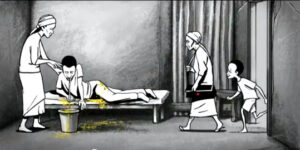CLEVELAND, Ohio — Cleveland’s Indigenous community wants to be seen.
Most educational curriculums teach about Native Americans during the early days of European settlement, including wars. But members of Cleveland’s Indigenous community want to be recognized as a thriving part of contemporary society.
“I was taught in the Cleveland public school system that my people were extinct,” said Philip Yenyo, executive director of the American Indian Movement of Ohio. “And then when you do find out that your people are not extinct, you say, ‘Oh my God, that’s verification that I am alive, I am a human being.’”
Marie Toledo, 56, is a registered tribal member of the Jemez Pueblo, a federally recognized Indigenous tribe in New Mexico. Toledo, a Cleveland-area native who grew up in Brooklyn Heights, is happy to share her story and heritage with anyone who wants to learn and listen.
She feels seen on a personal level, but she thinks Native Americans are not visible within modern society as a group.
A 2015 Penn State University study found that nearly 87% of the content taught about Native Americans within U.S. public school standards was in a pre-1900 context, with only about 13% taught in a post-1900 context.
With curriculums teaching a limited history of Native Americans, it leads to cultural invisibility.
“As a people, we don’t exist,” Toledo, a goldsmith jeweler, said in an interview with cleveland.com. “They tried to disappear us.”
Cynthia Connolly, an executive board member of the Lake Erie Native American Council, referenced the study and said the community wants Native Americans to be talked about as a “modern, living people” in the K-12 curriculum.
“We’re almost always pushed in the historical past,” said Connolly, a citizen of the Little Traverse Bay Bands of Odawa Indians in northern Michigan. “And it makes it very difficult for people to view us as a modern people and empathize with our modern issues when they only view us as feathered and leathered from the 1800s.”
Indigenous people also need more representation in modern media and culture, said Josh Hunt, a Cleveland native who is Cheyenne and white.
Hunt, 36, noted TV shows like “Reservation Dogs” and “Rutherford Falls” have provided representation, but more can be done to show Native Americans in contemporary media.
“And those things need to have Native Americans living in the 21st century,” said Hunt, a server at a brunch café who’s working toward a career in occupational therapy. “Living on the reservation, living off the reservation, living in cities. Because I don’t live in a teepee, and I don’t ride a horse. But I do live in a house, and I like to play video games, and I love to watch the show Stranger Things.”
Termination and relocation
The United States has mistreated and disenfranchised Native Americans over the course of its history, including through violence and forced removal from native lands.
The Indian Removal Act of 1830 relocated Indian tribes so European Americans could settle their land. It spawned the Trail of Tears, forcing Native Americans to march to territory west of the Mississippi River.
During the post-World War II and Civil Rights eras, the U.S. government adopted a policy of termination. That included the removal of governmental support for Native American tribes, and the end of “protected trust status of all Indian-owned lands,” according to the National Archives.
Termination worked in tandem with relocation. The Bureau of Indian Affairs started an urban relocation program where Native Americans could move to cities such as Chicago, Detroit, Cleveland, Seattle and Oakland. Cleveland was one of the last cities the government used during the relocation program.
The overall goal was to assimilate Native Americans into American mainstream society and eradicate the culture, Toledo said.
“At this point in the 2020s, their goal was for us to be gone,” said Toledo, whose dad was part of relocation. “To be completely absorbed into the melting pot of America, I guess.”
Toledo knows families who lost touch with their heritage after their relocation and assimilation to their new environment.
“Their kids married non-natives, they have non-native children and they have just diminished their blood line,” Toledo said. “And they don’t know anything about their culture. Nothing. They are on the path of disappearing.”
The relocation program was funded by the federal government, said Jessica Vallejo, whose parents were relocated.
Vallejo is Diné — also known as the Navajo people — and she also has Yaqui and Mexican heritage. She grew up in Toledo and has lived in Cleveland the past 10 years. Her father was born during his family’s trek to Ohio from Texas; her mother was born in Port Clinton.
One of the negative effects of relocation is that it’s hard for families to know their history. Since Vallejo’s father was born on the way to Ohio, his exact birthplace is unclear. He served in the Vietnam War and had a Social Security number, but when he applied for his pension, he was asked for his birth certificate. He was 52 years old and didn’t have one, Vallejo said.
“We know what we know, and sometimes there isn’t a way for us to recover the history, which is what’s so detrimental about these relocation families like mine,” said Vallejo, secretary for the Committee of 500 Years of Dignity and Resistance, a Northeast Ohio Native American activist group. “They’ve grown up away from anybody who can tell them (the history.)”
Growing up Native
Hunt, the brunch café server, attended St. Edward High School while growing up in Cleveland’s West Park neighborhood.
Hunt heard racist remarks from some of his classmates, and he said students would ask questions like “What are you?” in regards to his ethnicity.
“It felt just bad,” Hunt said. “It felt degrading. Why are they asking me that? Why are they asking me that question, and why are they asking me like that? Like, ‘What are you? … because you don’t fit exactly a stereotype in my mind, so what are you?’”
Hunt said he would respond that he’s Indian, but then students would ask, “Well, what kind of Indian?” and proceed to make insensitive and offensive gestures. He said they would first take the tip of their index finger and point at their forehead. Then the students would slap their mouths and make an insensitive war-whoop gesture.
Hunt attended Cleveland State University from 2011 to 2016, where he took some Native American studies classes and got more in touch with his heritage. As he learned more, he was motivated to embrace his Cheyenne identity. He wanted to read about as much Cheyenne culture and history as he could, and he also reached out to fellow Cheyenne people on social media. He also got in touch with his Cheyenne grandfather, who he did not have a prior relationship with.
As he learned more about his culture, Hunt felt he had to learn the Cheyenne language. He also wanted to learn how to dance, sing and drum and make regalia.
But one of Hunt’s friends in Cleveland, who is also Native, pointed something out to him: Hunt was trying to “become native,” when in fact he already was.
“And that was so powerful to me,” Hunt said. “It was so emotional to me. I just about cried in that moment. Here I was trying to become something that I already was, that I already am. And that was just super powerful for me.”
Keeping the culture alive
The Lake Erie Native American Council is one way members of Cleveland’s Indigenous community keep their various cultures alive.
Jessica Vallejo, the secretary with the Committee of 500 Years of Dignity and Resistance, said the Cleveland community is made up of Lakota people, Diné people and people from Oklahoma, which is filled with various tribes.
“We sit down and we realize that we are all living this urban experience,” Vallejo said. “We are all being separated from our culture by distance, so we have to seek it.”
A group’s relationship to its culture shows its past, but it also illuminates what’s in store for the future.
Robert Rice, 26, identifies as a Black Native and is a tribal citizen of the Saponi Nation; he is also of Catawba and Tuscarora descent. He’s studying anthropology at Cuyahoga Community College with hopes of transferring to Cleveland State University for the spring semester.
In an interview with cleveland.com, Rice evoked a teaching, significant to several tribal nations, that every action must be taken with a sense of responsibility for the people and community – a sense of awareness for how the next seven generations will be affected by the decisions of today.
The concept serves as a reminder that someday, they will be considered ancestors by a future generation, so they need to maintain the culture for their descendants.
“It helps keep us grounded in who we are and keeps us together as a community, moving forward for the next seven generations,” Rice said.




